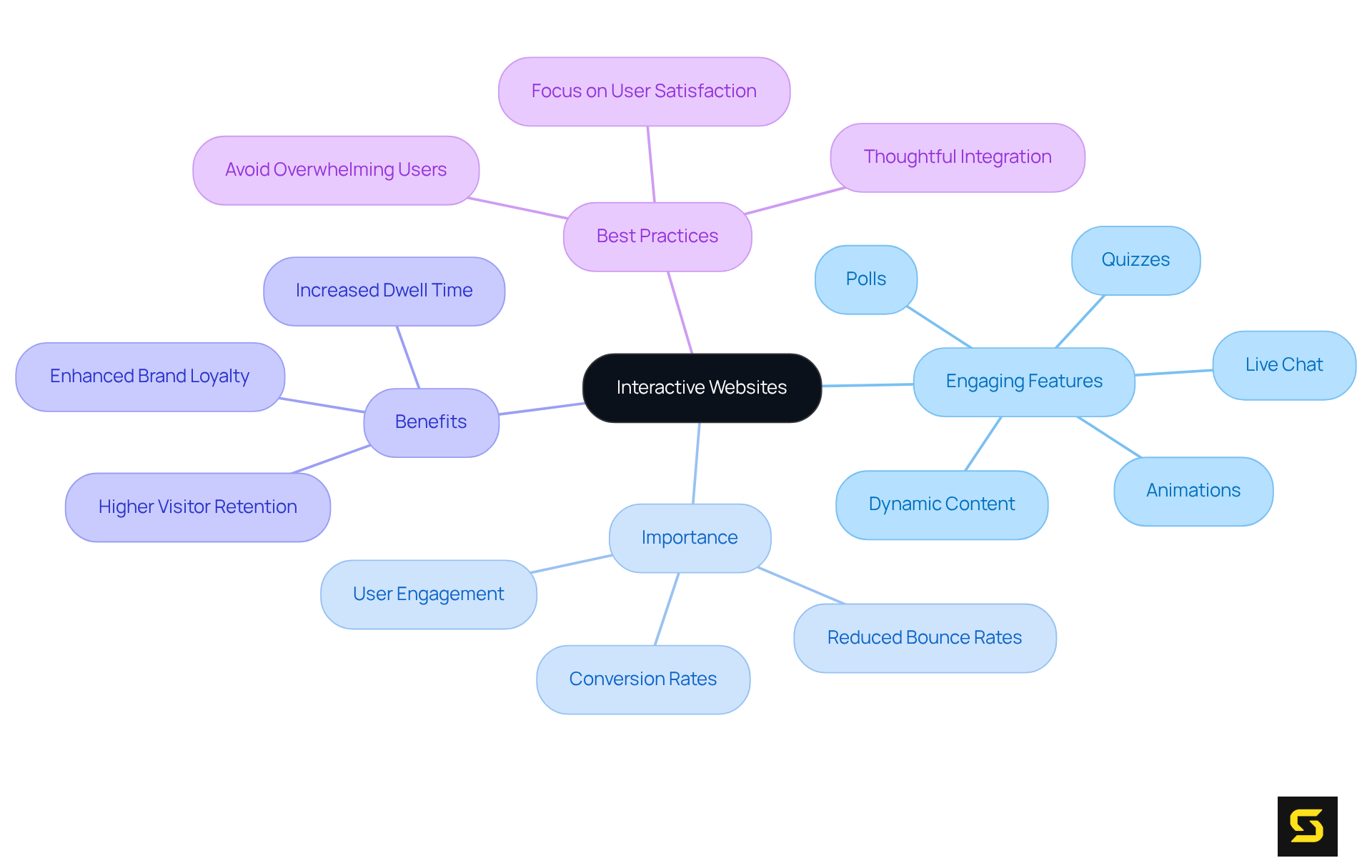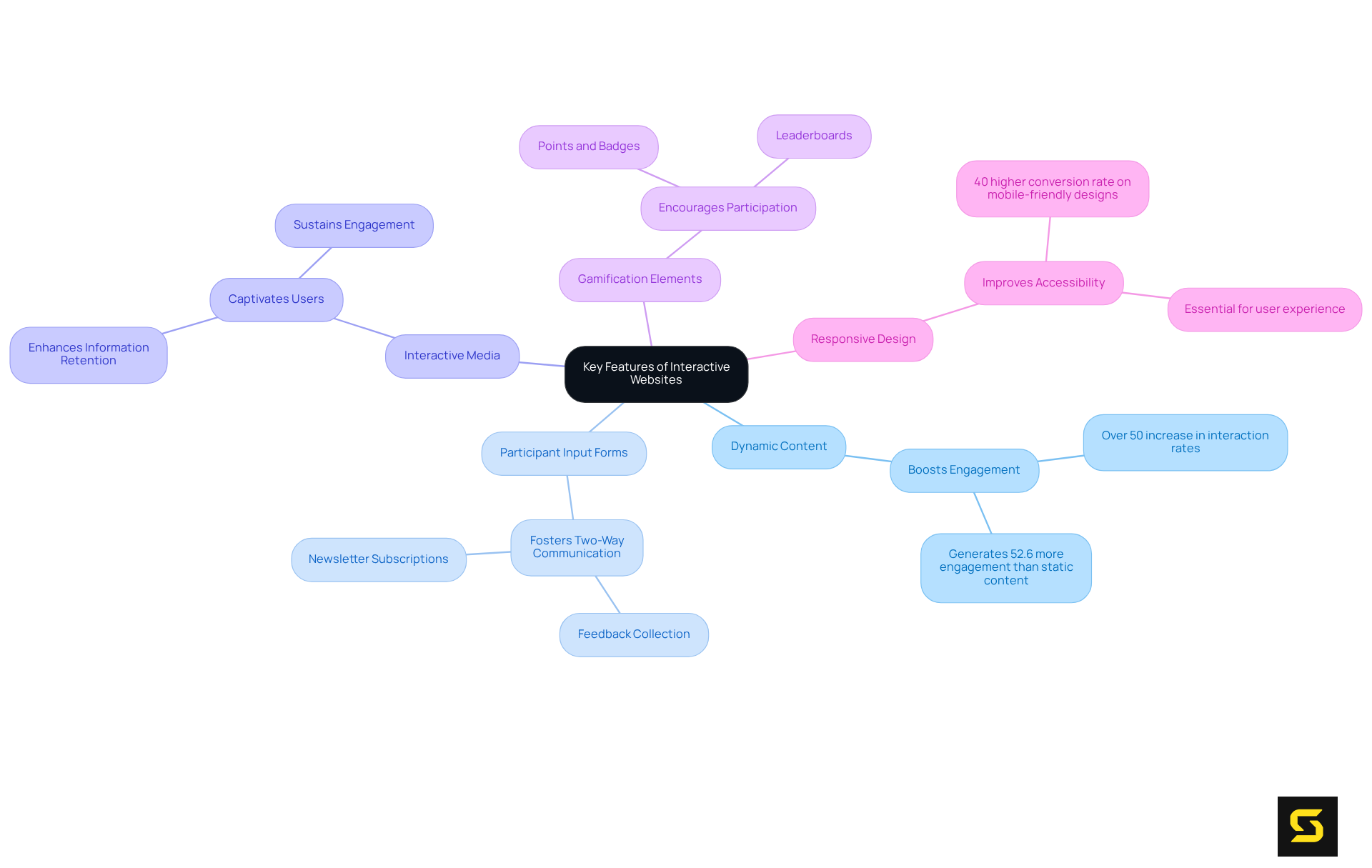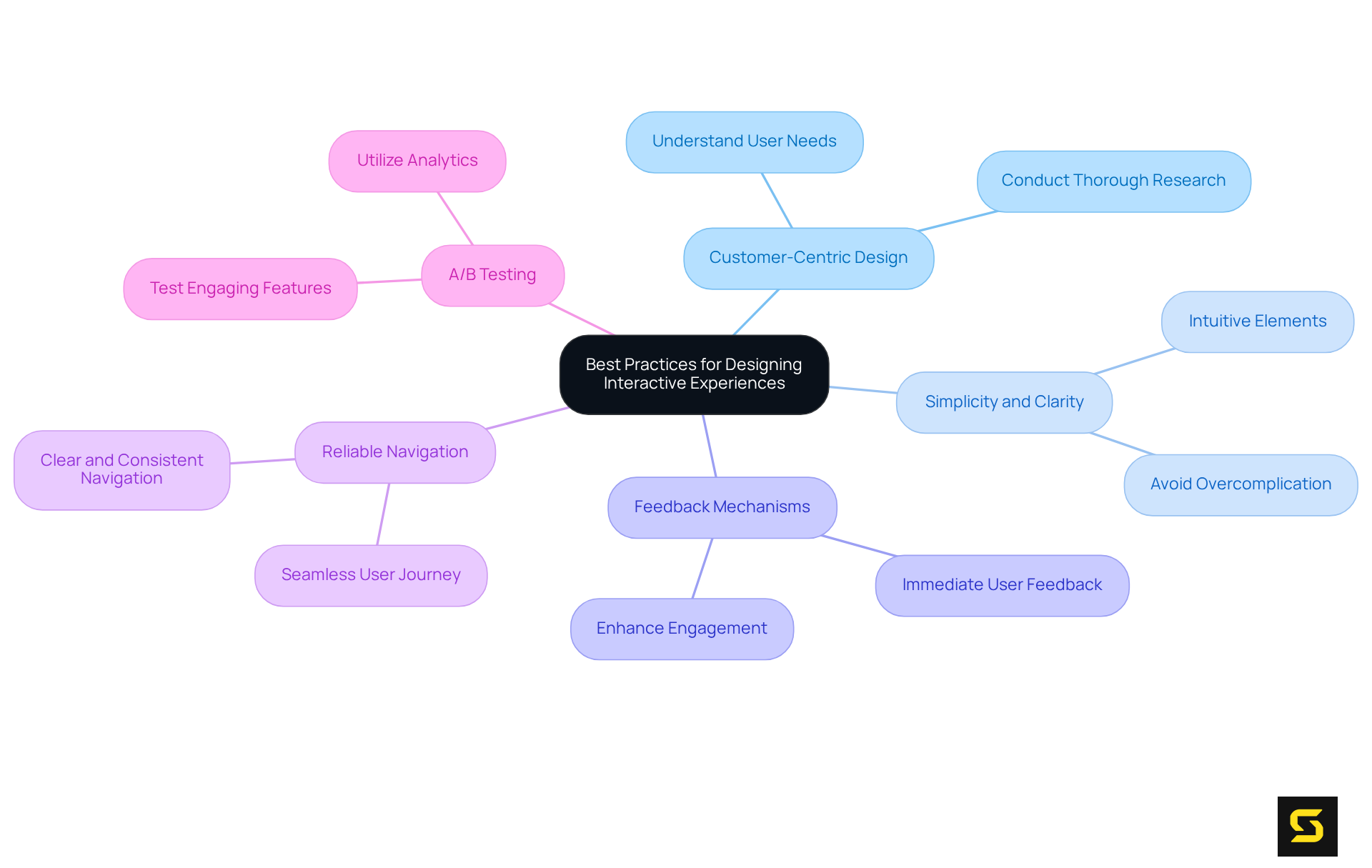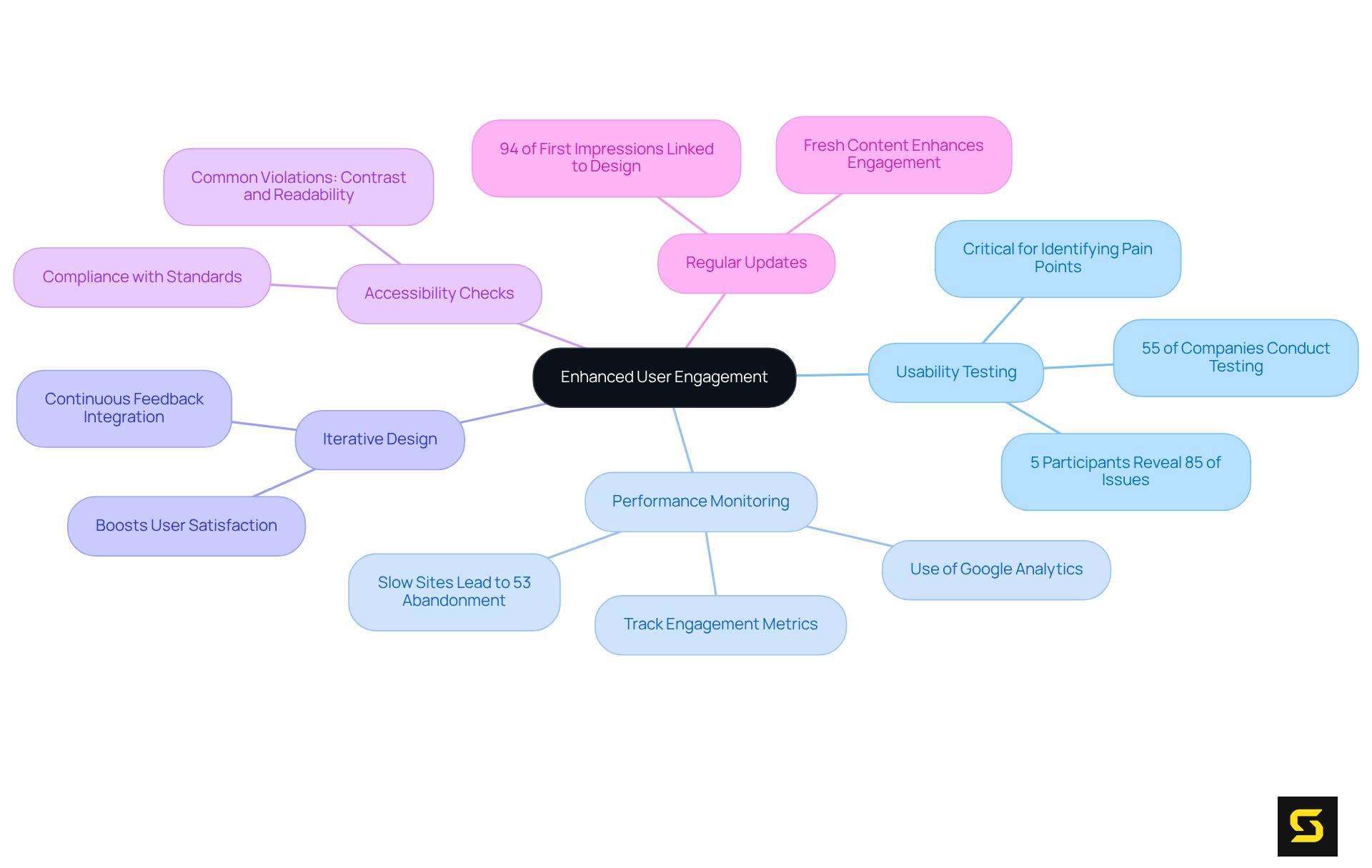Overview
Best practices for creating engaging interactive websites hinge on a customer-centric design approach. By prioritizing simplicity and clarity in interactive elements, developers can significantly enhance user experience. Furthermore, implementing effective feedback mechanisms is crucial. These strategies not only improve user engagement but also elevate satisfaction levels, which are essential for driving retention and conversion rates. Regular usability testing and performance monitoring further solidify these outcomes, ensuring that websites meet user expectations and adapt to their needs. Embrace these practices to transform your website into a powerful tool for engagement and success.
Introduction
Creating an interactive website is no longer merely a trend; it has become an essential strategy for brands seeking to captivate their audience in a digital landscape overwhelmed with static content. By integrating features such as:
- Quizzes
- Dynamic content
- Gamification
businesses can significantly elevate user engagement, resulting in longer visit durations and improved conversion rates. However, despite these evident advantages, many brands grapple with striking the right balance between interactivity and user satisfaction. What are the best practices for designing engaging online experiences that not only attract visitors but also ensure they return for more?
Define Interactive Websites and Their Importance
Interactive websites actively engage individuals, encouraging them to participate in the content rather than merely consuming it. Elements such as quizzes, polls, animations, and dynamic content that respond to participant actions are essential for creating interactive websites. The significance of interactive websites lies in their ability to , extend the time spent on the site, and ultimately drive conversions.
Research indicates that engaging features can reduce bounce rates by fostering a more enjoyable interaction; for instance, immersive online environments have been shown to increase dwell time by 40% compared to traditional social feeds. Companies that integrate engaging elements into their interactive websites often witness a substantial rise in visitor retention and conversion rates, as users are more inclined to return to interactive websites that offer a dynamic and immersive experience.
A survey conducted by Pinterest revealed that over 85% of individuals prefer interactive websites to static pages, highlighting a shift in expectations and the necessity for brands to adapt. Successful implementations, such as those seen in fitness platforms that promote shared accountability through engaging features, demonstrate how these designs can significantly enhance involvement and loyalty, ultimately leading to higher conversion rates.
However, it is crucial to avoid common pitfalls in web design, such as overwhelming users with an excessive number of engaging elements or neglecting to ensure that these features enhance rather than detract from user satisfaction. By concentrating on the thoughtful integration of interactivity, brands can create interactive websites that offer compelling online experiences resonating with their audience.

Identify Key Features of Interactive Websites
Essential features of interactive websites are crucial for maximizing user engagement and driving conversions.
- Dynamic Content: This refers to content that adjusts based on interactions, such as personalized recommendations or layouts that change according to preferences. Dynamic content significantly enhances engagement, with studies indicating that it can boost interaction rates by over 50% compared to static content. Moreover, interactive content generates 52.6% more engagement than its static counterparts, underscoring its effectiveness.
- Participant Input Forms: These forms empower individuals to provide feedback, subscribe to newsletters, or make inquiries, fostering a two-way communication channel that enhances participant involvement.
- Interactive Media: The incorporation of videos, infographics, and animations that promote interaction—such as clickable elements or embedded quizzes—can captivate users and sustain their engagement for extended periods. For instance, interactive infographics have been shown to enhance information retention and audience satisfaction significantly.
- Gamification Elements: Features like points, badges, or leaderboards introduce a competitive aspect to interactions, encouraging participation. This approach has proven effective, with brands reporting and loyalty.
- Responsive Design: Ensuring that engaging components function seamlessly across all devices is crucial for improving accessibility and user experience. Mobile-friendly designs can yield a 40% higher conversion rate, highlighting the importance of optimizing for various platforms.
By integrating these features, websites can cultivate a more immersive and captivating atmosphere that not only attracts visitors but also motivates them to return. However, it is critical to be mindful of common pitfalls, such as ensuring mobile optimization and avoiding overwhelming users with excessive engaging elements. As noted, 'Dynamic content is vital in contemporary marketing by allowing businesses to provide tailored interactions,' emphasizing the significance of these attributes.

Implement Best Practices for Designing Interactive Experiences
To design effective interactive websites, it is essential to adhere to best practices that prioritize user engagement and satisfaction.
- Customer-Centric Design: Prioritize the experience of individuals by deeply understanding their needs and preferences. Conduct thorough research to inform your design decisions, ensuring that every choice resonates with your audience.
- Simplicity and Clarity: Keep interactive elements straightforward and intuitive. Overcomplicating features can overwhelm users and detract from their overall experience, so strive for clarity in every interaction.
- Feedback Mechanisms: Implement immediate feedback for user actions, such as animations or notifications. This enhances engagement and satisfaction, making users feel connected to the experience.
- Reliable Navigation: Ensure that navigation is clear and consistent throughout the site. This enables visitors to effortlessly locate engaging components, fostering a seamless user journey.
- A/B Testing: Regularly test different engaging features to identify what resonates best with your audience. Utilize analytics to and adjust your strategy accordingly, ensuring continuous improvement.
By following these practices, designers can create interactive websites that engage visitors and achieve the intended results, solidifying their expertise in the field.

Test and Optimize for Enhanced User Engagement
Implementing thorough testing and optimization strategies is essential to maintain user engagement on interactive websites.
Usability Testing: Conducting usability assessments with actual participants is critical for identifying pain points and areas for enhancement. Qualitative feedback is crucial for comprehending user experiences; studies indicate that testing with just five participants can reveal 85% of usability problems. Notably, 55% of companies engage in some form of online usability testing, underscoring its significance in the industry.
Performance Monitoring: Utilizing tools like Google Analytics to track interactions and engagement metrics is vital. Consistent examination of this data aids in recognizing trends and aspects that require improvement, ensuring that the platform meets visitor expectations. can lead to substantial revenue losses, as 53% of visitors abandon sites that take longer than three seconds to load.
Iterative Design: Embracing an iterative design approach, where participant feedback is continuously integrated into the development process, enables ongoing enhancement of engaging elements, thereby boosting overall user satisfaction.
Accessibility Checks: Ensuring that all engaging features comply with accessibility standards is imperative for making them usable for individuals with disabilities. Common violations include insufficient contrast ratios and poor text readability. This commitment not only broadens your audience but also fosters a more inclusive online environment.
Regular Updates: Keeping content fresh and relevant through routine updates of interactive elements enhances audience engagement and positively influences SEO performance, as search engines favor regularly updated content. Furthermore, 94% of initial perceptions are linked to a site's design, emphasizing the vital importance of visual design in audience interaction.
By prioritizing these testing and optimization strategies, organizations can develop interactive websites that adapt to evolving user needs and preferences, ultimately driving higher engagement and satisfaction.

Conclusion
Creating engaging interactive websites is essential for fostering user involvement and driving conversions. By incorporating dynamic elements that encourage participation, brands can transform passive visitors into active participants, enhancing their overall experience. This shift not only meets the evolving expectations of users but also leads to improved retention and loyalty.
Key strategies for achieving this include integrating essential features such as dynamic content, interactive media, and gamification elements. These components, designed with user-centric principles in mind, significantly boost engagement levels. Furthermore, implementing best practices like simplicity, clear navigation, and regular A/B testing ensures that interactive elements enhance rather than overwhelm the user experience.
Ultimately, the importance of interactive websites extends beyond mere aesthetics; they are crucial for creating memorable online experiences that resonate with users. As digital landscapes continue to evolve, embracing these practices empowers brands to cultivate deeper connections with their audiences and achieve sustainable growth. Prioritizing user engagement through thoughtful design and continuous optimization not only benefits individual websites but also contributes to a more vibrant and interactive online ecosystem.
Frequently Asked Questions
What are interactive websites?
Interactive websites are platforms that actively engage users, encouraging them to participate in the content through elements like quizzes, polls, animations, and dynamic content that respond to user actions.
Why are interactive websites important?
Interactive websites enhance visitor involvement, increase the time spent on the site, and drive conversions. They create a more enjoyable user experience, which can lead to higher retention and conversion rates.
How do engaging features affect user behavior on websites?
Engaging features can reduce bounce rates and increase dwell time. Research shows that immersive online environments can increase dwell time by 40% compared to traditional social feeds.
What do statistics say about user preferences for interactive websites?
A survey by Pinterest revealed that over 85% of individuals prefer interactive websites over static pages, indicating a shift in user expectations and the need for brands to adapt.
Can you provide examples of successful interactive website implementations?
Fitness platforms that promote shared accountability through engaging features are examples of successful interactive websites. These designs significantly enhance user involvement and loyalty, leading to higher conversion rates.
What are common pitfalls to avoid when designing interactive websites?
Common pitfalls include overwhelming users with too many engaging elements or failing to ensure that these features enhance user satisfaction. It is important to thoughtfully integrate interactivity to create compelling online experiences.





